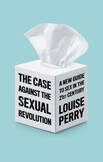Review: The sexual revolution has hurt both men and women. Where do we go from here?
Louise Perry’s tour de force, The Case Against the Sexual Revolution, so thoroughly decimates any case for the sexual revolution that hardly a shred is left standing. Her book also raises a question difficult to answer: Given the fraught situation in which the sexual revolution has left many women and men, where do we go from here?
The London-based Perry, a journalist in her early 30s and a new mother, celebrates the gains of reliable family planning methods and professional opportunity which modernity has delivered to women. Indeed, Perry’s own identification as a non-religious feminist renders her critique of sexual liberation (at least for the heterosexual majority, on whom the book is wholly focused) even more searing. One by one, the lessons about sex that mainstream, secular feminism offers to young, heterosexual women are revealed as lies by her honest gaze.
One by one, the lessons about sex that mainstream, secular feminism offers to young, heterosexual women are revealed as lies by Perry's honest gaze.
Perry makes several arguments that are anathema to most of today’s self-identified feminists: first, that the average woman and the average man approach sex differently; second, that sexual liberation has ultimately freed men to prey upon women more than it has freed women to access sexual pleasure; and third, that pornography and sex work exploit women and infantilize men.
Leading the reader through each of these arguments, Perry slays mainstream, secular feminist sacred cow after sacred cow, offering meticulous defenses of her premises in response to nearly all the anticipated objections to her argument.
“But women and men are only as different as we socially construct them to be!” Nope: Evolutionary biology has left the average manfar higher than the average woman in the personality trait called “sociosexuality,” which refers to how much sexual variety itself turns a person on. Obviously, there are some men that are low in sociosexuality and some women that are high in it; those are the rare exceptions that prove the overwhelming rule. Therefore, to the extent that mutual monogamy requires repression, it is men more than women who will feel repressed.
“But women are sexually liberated now and enjoying sex just like men always have!” Nope: Women do not achieve sexual pleasure in casual encounters at anything close to the rate that men do. Where do women achieve sexual pleasure with most regularity? In the kinds of committed, monogamous relationships that often comprise co-parenthood and that many single women are seeking.
One of Perry’s most interesting arguments is that our anarchic sexual culture is reproducing a 21st-century version of polygamy.
“But sex work is just work, and pornography broadens the scope of sexual relationships!” Nope: In addition to its overwhelming exploitation of women, a pornographic culture has inflected sexual relationships between men and women. Women who want to say “no” to sex on a first date, or to the kinds of rough sexual acts that are depicted in today’s most popular pornography, are at a disadvantage in a pornified sexual marketplace. Meanwhile, erectile dysfunction and involuntary celibacy are on the rise among young men, and there is evidence to suggest that abundant consumption of pornography is at least partly to blame.
One of Perry’s most interesting arguments is that our anarchic sexual culture is reproducing a 21st-century version of polygamy, where high-status, desirable men attract many women and are difficult for any individual woman to pin down, while lower-status, less attractive men attract no women and are left without access to sex or partnership. Today, Perry argues, there are many more unmarried 20-something and 30-something women looking for mates than in previous generations, as well as many more young men who report having had sex with zero partners in the past year.
This neo-polygamy is fueled by a few different realities simultaneously—each of which encompasses individual gains but also societal trade-offs.
First, women now pay less of a social price for staying single longer. A 30-something single woman is not considered a “spinster” anymore, and is therefore less likely to settle in her choice of mate. Second, online dating creates the illusion—or reality—of endless choice for both women and men. Finally, Perry explains, polygamy, not monogamy, is the natural state of the human animal as well as the historical rule. Evolution has wired us to maximize the odds of survival by having the most seemingly successful men produce as many children as possible. Polygamy leaves many males out of the reproductive scheme altogether, and necessitates that females share male partners.
The widespread expectation of monogamy that reigned in the West until quite recently was, Perry argues, a kind of “sexual socialism,” in which everyone was expected to get a reasonably equal share of sex and companionship via a primary romantic relationship. The pressure to couple up relatively young meant that, while many people settled for partners that they might have deemed less desirable than the ideal, almost everyone found a partner. Perry contends that a return to that system would benefit most individuals (female and male) as well as society writ large. I wholeheartedly agree.
But how do we get there?
Unfortunately, Perry doesn’t have a real answer. I do, though. There is only one force with any empirical record (partial and flawed though it is) of achieving the more even sexual playing field that she endorses in a large, free and multiethnic society like our own. That force is explicitly religious morality.
Nature—as in, red in tooth and claw—is brutal. Stronger animals tend to dominate weaker ones if they can. As Perry points out, men tend to be physically larger and stronger than women, and to have much higher sex drives.
Hence, any social system that seeks to prevent among human beings the kind of “objectification of women” that feminists have rightly condemned—not to mention the kind of sexual intercourse by force (i.e., rape) that is quite common among lower animals—will have to do one of two things: police all men every waking moment, or inspire men to police themselves. Since the former is impractical to the point of impossibility, we are left with the latter.
Many men are agreeable enough by nature that typical socialization in basic sympathy is more than enough to keep them from intentionally hurting women, physically or emotionally. “Nice guys” do, however, hurt women unintentionally, having unthinkingly (and, yes, self-interestedly) bought the modern feminist canard that most women are no different from most men when it comes to sex. Moreover, as Perry demonstrates and as we all know, brutal nature burns within each of us, whether we acknowledge it or not. We are, after all, animals; and animals are dangerous.
So how we conceptualize the basic regard for others that is supposed to make us behave in pro-social, civilized ways—it matters. It is not enough to know that we should treat other people with dignity. We have to be able to articulate why.
One answer to the question of why others are worthy of our freely given regard and respect (why a man should not use his neighbor for sex, even if he is pretty sure he will suffer no reputational or other damage for doing so) that has both genuine intellectual heft or spiritual depth involves religion.
It is not enough to know that we should treat other people with dignity. We have to be able to articulate why.
If women and men are created in the image and likeness of an all-loving, all-knowing God, then using another person for sexual gratification (or for any merely selfish end) is inhumane and evil. But if there is no such God, then why not treat people—sexually and otherwise—however you can get away with? A godless version of the golden rule, in which well-meaning Westerners without an explicitly religious framework tend to instruct their children, is an inherently weak bulwark against the lack of a societal answer to this question. In arguing against the use of artificial contraception in “Humanae Vitae” (1968), Pope Paul VI contended that the decoupling of sex from procreation—in short, the sexual revolution—would cause men to “forget the reverence due to a woman” and to “reduce her to being a mere instrument for the satisfaction of his own desires.”
It is easy to criticize the late pontiff’s argument here, even though he has been proven prophetic. After all, he was blaming the pill for an ostensibly forthcoming reality in which men would treat women badly—but many women had already been treated badly by men throughout history, including during the 1,400 years when Judeo-Christian morality was nominally ubiquitous. Sadly, there has never yet been a society in which some powerful men did not use and abuse many poorer, more vulnerable women—sexually and otherwise.
One solution to that perennial injustice—and the one for which the earliest feminists of the 19th century advocated—could have been to expand the cultural understanding of the “image and likeness of God” to include women of all races and classes, rather than just white women of means.
Instead, the sexual revolution’s decoupling of sex from traditional religious morality and mores altogether in the West means that any woman of any class is now fair game for objectification, provided she has offered the clinical “consent” that makes her a participant in her own maltreatment. This has been an unmitigated disaster, as Perry courageously makes clear.
It is also the entrenched reality, and untold damage has already been done. Indeed, Perry dedicates her book to “the women that learned the hard way.” I hope that those of us raising sons and daughters today will be honest with our children about the fact that some inculcation in the enduring wisdom of religious morality is the necessary foundation for any easier way.
This article also appeared in print, under the headline “Sex Without Religion,” in the January 2023, issue.











